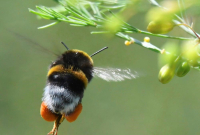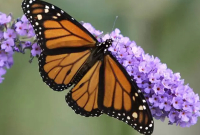Support strong Canadian climate journalism for 2025
Research measuring the effort of climate change on bees suggests they are only half as likely to be found in areas where they were once common.
"Things are just getting way too hot for them in a lot of places, too frequently in the year," said Peter Soroye, a biologist at the University of Ottawa.
Bees are crucial to agriculture. The United Nations says about one-third of the world's crops depend on pollinators.
Bees have faced a series of threats for years, including habitat loss, parasites and pesticide use. One 2011 study found that wild bumblebee species had declined by up to 96 per cent and their ranges had contracted by at least one-quarter.
Climate change is also a factor. Soroye and his colleagues, whose research was published Thursday in the journal Science, wanted to tease out its part in the bees' decline.
Although global warming is usually reported in terms of average degrees per year, climatologists say that's not how it's actually experienced. What usually happens is a period of extreme weather.
That's what hurts the bees, Soroye said.
"Temperatures getting a little hotter every year, most species can probably tolerate that," he said. "But when you get a week of 40-plus (Celsius) temperatures, this is something that's really difficult for bumblebees to tolerate."
Using almost a century's worth of records and data on 66 bumblebee species from more than half a million locations, the researchers showed a clear correlation — separate from land use or pesticides — between bee population surveys and weather that exceeded their tolerance.
They found a powerful link between population decline and what the paper calls "climate chaos."
"Eureka moments don't usually happen," said co-author Jeremy Kerr, a University of Ottawa professor. "Usually you see something in your data and you squint a little bit and then you say, 'That's strange.' But this time, everything you could think of totally worked."
The paper concludes that climate change in North America has resulted in a 50-50 chance that a meadow or a vacant lot that was loud with bees just a generation or two ago still has them. The paper also says their risk of extinction has increased.
Not all changes are losses. Soroye said some areas benefited from the warmer weather and increased their bee numbers.
But the overall trend was down, he said.
Kerr said correlating populations with weather data could be useful to help understand the declining numbers of many other species, especially birds for which long records are available.
"The premise is intended to be transferable. We didn't build the premise for bumblebees. We built it for any kind of species."
Not all animals are necessarily in decline from climate change. Butterflies, for example, might not be bothered by hot spells.
"They originated in tropical conditions and they may have greater capacity to tolerate hot weather," Kerr said.
But the reason for any changes would remain the same — climate.
"These principles are applicable everywhere," Soroye said. "We have yet to test that, but that's what we think."
Kerr said the study has the added benefit of being immediately useful to beekeepers or wildlife managers.
"If we can manage our habitats to maintain things like microclimates, little habitat buffers like a hedgerow, it has the same effect as putting a shade tree in your backyard on a hot day," he said. "You can go sit in the shade and so can a bumblebee."
This report by The Canadian Press was first published Feb. 6, 2020






Comments